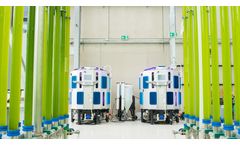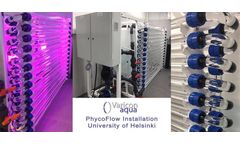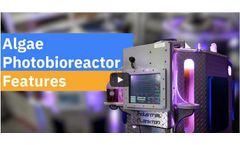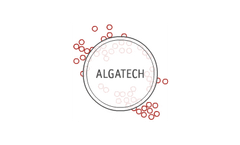Photo Bioreactor Articles & Analysis
18 articles found
The Drive Towards Scalable and Efficient Algae Production Producing algae as a commodity for feed, pharmaceuticals, nutraceuticals, carotenoids, and pigments calls for expansive setups. Executing this production at scale and making this economical, vast installations like raceway ponds or extensive tubular systems are required. However, the efficiency of these systems hinges on a critical ...
Varicon Aqua’s latest project is up and running in Hong Kong, with the installation led in person by our Managing Director, Joe McDonald. The client, Geb Impact Technology Company Limited, will be using two of our reactor systems, the Phyco-Lift and the Phyco-Pyxis, the latest in our range of innovative products. Geb Impact and Varicon Aqua have enjoyed a long professional relationship, ...
Following detailed consultation with Algae Bulgaria our team recently installed and commissioned a pilot scale Phyco-Flow system at their production facility in Stara Zagora. Algae Bulgaria is a company founded by a young team of entrepreneurs who are passionate about the potential of microalgae within the nutraceutical markets (https://spirulina.bg/). They cultivate Spirulina and sell the ...
We are delighted to have completed our latest 12,000 L Phyco-Flow photobioreactor installation for Algaecytes UK. This Phyco-Flow is the most recent example of our multi photo-stage photobioreactor, designed specifically for industrial scale production of microalgae. The system incorporates full process control, with data acquisition and remote access alongside integration of upstream and ...
Another Varicon Aqua project completed – two bespoke Phyco-Lift systems with working volumes of 1.5 m3 and 3 m3 respectively; featuring a full suite of sensors and process control, including an automated shading array. Working closely with our client to deliver their exact requirements this unique design allows for operation in both airlift and bubble column configurations. Furthermore, the ...
We recently installed 4 x 70L capacity Phyco-Lift, airlift photobioreactors utilisng Schott Glass components. Incorporating a full suite of controls with data acquisition and controllable, dimmable LED lighting, sterile dry air drives the systems with CO2 injection for pH control. Simple elegant research tools capable of producing a very wide array of micro algae, diatoms and ...
The latest image a pair of 2 x 7000 L Phyco-Flow photobioreactor systems. Each with full process control, cooling, shading, data acquisition, remote access, automated harvesting and downstream processing. The client is bio-prospecting for high value compounds and reports that the system is performing well post inoculation, with no cell damage and good growth rates. ...
The Varicon Aqua team have recently returned from Finland, where we are pleased to have installed a top of the range Phyco-Flow System for the University of Helsinki. Researchers will use the tubular photobioreactor, situated on the Lahti campus (Faculty of Biological and Environmental Sciences), to cultivate microalgae in support of their on-going projects. One such project, Algae Factory, ...
We are pleased to announce the latest installation of a 2750 L Phyco-Flow system for Grupo Fagro at their new Micro Algae Technology Development Unit, Biorganix in Ramos Arizpe, Mexico in conjunction with Novel Agricultural Bioactives from Microalgae (NAMBA) initiative. Our Phyco-Flow tubular photo-bioreactor will be used to cultivate microalgae species for the ...
Varicon Aqua & Academic Collaboration Varicon Aqua has been involved with many academic and professional research institutions over the years, adapting our developmental processes to the fast paced and dynamic aims of the research community. Each project is specific and bespoke, providing a range of challenges to our design team. Many of these design innovations find their way into the next ...
Algae bioreactors (PBR) Features – Easy algae cultivation Traditional algal culture techniques are unreliable and labour & space-intensive. Our photobioreactors make algae growth simple by automating routine tasks. Algae grows incredibly dense in our PBRs’ custom-designed high surface area sealed tank and it stays clean as everything entering the PBr is sub-micron filtered. We ...
What are open and closed algae culture systems? The two broadest methods of culturing algae at medium to large scale are split into two styles of system: open and closed photobioreactors (PBRs). A PBR is any device or system that supports the culture of photosynthetic organisms using light. There are photobioreactor advantages and disadvantages to both types systems depending on the goals you ...
Industrial Plankton’s photobioreactors make business easier for companies around the world. And they are located in Victoria! Using traditional methods, algae production can be a difficult and error-prone process. “We found out that everybody in aquaculture was having trouble growing algae, and they were doing it with old-school methodologies,” says Robert Roulston, CEO of ...
Paris, France, 22 May 2019 - Solabia Group ("Solabia") today announces that it has acquired Algatech Ltd. ("Algatech" or "the Company"), a global innovative leader in the development, cultivation and commercialisation of ingredients delivered from microalgae and used by leading food supplement, food and cosmetic brands worldwide. Solabia, a family-owned company working closely with its minority ...
ByAlgatech
Several obstacles and limitations currently prevent the industrial exploitation of microalgae for feed, food and biofuel production. Photobioreactors (closed systems for algae cultivation) suffer from high-energy expenditures for mixing and cooling, while cultures in large-scale open ponds, which have a more favorable net energy ratio, are unstable ecosystems in which maintaining selected strains ...
The paper reports the results of an experiment to assess the feasibility of including a photobioreactor within the design of a wastewater treatment plant, growing microalgae on the centrate from anaerobic sludge dewatering. The growth of algal biomass would take advantage of the available nitrogen and provide a substrate for biogas production by anaerobic digestion. Tests were carried out by ...
Chlorellais one of the few microalgae employed for human consumption. It typically has a high protein content, but it can also accumulate high amounts of lipids or carbohydrates under stress conditions and, for this reason, it is of interest in the production of biofuels. High production costs and energy consumption are associated with its cultivation. This work describes a strategy to reduce ...
In this study, a novel optical panel photobioreactor (OPPBR) equipped with a V-cut/or flat optical panel (OP) and a light source, i.e., light-emitting diodes (LEDs) was developed. The performance of this OPPBR was assessed using cultures of Chlorella vulgaris. Growth rates of biomass were compared in bioreactors operated separately using a V-cut OP, or a flat-plate OP both equipped with LEDs or ...








